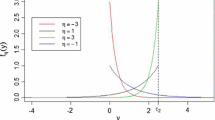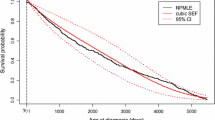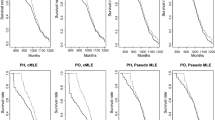Abstract
Lifetime data are usually assumed to stem from a continuous distribution supported on [0, b) for some b ≤ ∞. The continuity assumption implies that the support of the distribution does not have atom points, particularly not at 0. Accordingly, it seems reasonable that with an accurate measurement tool all data observations will be positive. This suggests that the true support may be truncated from the left. In this work we investigate the effects of adding a left truncation parameter to a continuous lifetime data statistical model. We consider two main settings: right truncation parametric models with possible left truncation, and exponential family models with possible left truncation. We analyze the performance of some optimal estimators constructed under the assumption of no left truncation when left truncation is present, and vice versa. We investigate both asymptotic and finite-sample behavior of the estimators. We show that when left truncation is not assumed but is, in fact present, the estimators have a constant bias term, and therefore will result in inaccurate and inefficient estimation. We also show that assuming left truncation where actually there is none, typically does not result in substantial inefficiency, and some estimators in this case are asymptotically unbiased and efficient.
Similar content being viewed by others
References
S. K. Bar-Lev and B. Boukai, “Minimum Variance Unbiased Estimation for Families of Distributions Involving Two Truncation Parameters”, J. Statist. Plann. Inf. 12, 379–384 (1985).
S. K. Bar-Lev and B. Boukai, “A Characterization of the Exponential Distribution by Means of Coincidence of Location and Truncated Densities”, Statist. Papers 50(2), 403–405 (2009).
P. J. Bickel, “Parametric Robustness: Small Biases can be Worthwhile”, Ann. Statist. 12(3), 864–879 (1984).
K. P. Burnham and D. R. Anderson, Model Selection and Multimodel Inference: A Practical Information-Theoretic Approach (Springer, 2002).
G. Claeskens and N. L. Hjort, Model Selection and Model Averaging (Cambridge Univ. Press, 2008).
T.M. Dubinin and S. B. Vardeman, “Likelihood-Based Inference in Some Continuous Exponential Families with Unknown Threshold Parameters”, J. Amer. Statist. Assoc. 98(463), (2003).
R. C. Elandt-Johnson, Survival Models and Data Analysis (Wiley, 1999).
J. F. Lawless, Statistical Models and Methods for Lifetime Data (Wiley, 2003).
R. F. Tate, “Unbiased Estimation: Functions of Location and Scale Parameters”, Ann. Math. Statist. 30(2), 341–366 (1959).
A.W. van der Vaart, Asymptotic Statistics (Cambridge Univ. Press, 2000).
H. White, “Maximum Likelihood Estimation of Misspecified Models”, Econometrica 50, 1–25 (1982).
Author information
Authors and Affiliations
Corresponding author
About this article
Cite this article
Vancak, V., Goldberg, Y., Bar-Lev, S.K. et al. Continuous statistical models: With or without truncation parameters?. Math. Meth. Stat. 24, 55–73 (2015). https://doi.org/10.3103/S1066530715010044
Received:
Accepted:
Published:
Issue Date:
DOI: https://doi.org/10.3103/S1066530715010044




